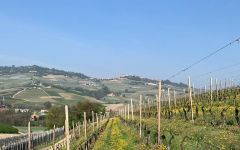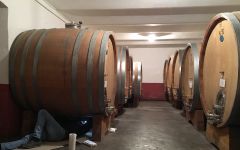Azelia Barolo 2017
-
James
Suckling -
Jeb
Dunnuck -
Wine &
Spirits -
Robert
Parker -
Wine
Enthusiast



Product Details
Your Rating
Somm Note
Winemaker Notes
Aroma and finesse with power and body at the same time. Sweet nose, with hints of cherry, black currant and licorice. Fruity tannins. A union of characters.
Professional Ratings
-
James Suckling
Fascinating aromas of ripe strawberry, bark, mushroom and black tea follow through to a full body with round, creamy tannins that are juicy and rather punchy. Try after 2024.
-
Jeb Dunnuck
Sourced from seven parcels across Castiglione Falletto and Serralunga d’Alba, the 2017 Barolo reveals medicinal aromatics of menthol, dried cherry, and nutmeg. The palate is angular with gripping structure and noted by cranberry cocktail, tea leaf, and orange citrus. This 2017 is classically built within the warmth of the vintage.
-
Wine & Spirits
Fruit for this spicy Barolo comes from seven single crus in Serralunga d’Alba and Castiglione Falletto. Firm, polished tannins frame the red-cherry and strawberry flavors, and the acidity is well integrated, drawing out those red fruit tones on a long and lively finish.
-
Robert Parker's Wine Advocate
The Azelia 2017 Barolo is fine and elegant, opening to a pretty ruby color that catches the ambient light. To the nose, it offers cherry and wild rose with licorice and campfire ash. You do notice the extra heft and dryness of the tannins, especially when the wine is tasted before its ideal drinking window. Luigi Scavino's classic Barolo is a blend of seven vineyard sites: Altenasso and Solanotto in Castiglione Falletto; a part of Cerretta; the youngest vines in Bricco Voghera that are 55 to 60 years old (the fruit from the 90-year-old plants goes to the Riserva); and parts of San Rocco, Cerrati and Broglio in Serralunga d'Alba.
-
Wine Enthusiast
Aromas of wild berry, eucalyptus and fennel seed mingle with blue flower. On the austere palate, tightly wound tannins accompany sour cherry, blood orange and licorice before a firm, rather lean finish.
Other Vintages
2019-
Robert
Parker -
James
Suckling -
Wine
Spectator - Decanter
-
Wine
Spectator -
James
Suckling -
Robert
Parker
-
James
Suckling -
Robert
Parker
-
Robert
Parker -
James
Suckling -
Wine
Enthusiast
-
Wine
Spectator -
Robert
Parker -
James
Suckling
-
James
Suckling
-
James
Suckling -
Wine
Enthusiast
-
James
Suckling -
Robert
Parker -
Wine
Spectator
-
Wine
Spectator -
James
Suckling






In 1920 Cavalier Lorenzo Scavino began to vinify part of the grapes produced in the family's vineyards, a small rural reality in the heart of the Langhe region, in Castiglione Falletto.
His son Alfonso started enthusiastically to bottle the wine produced and thanks to Luigi's father, Lorenzo, with perseverance and willpower, the wines were for the first time exported.
The Azienda Agricola Azelia, in the centre of the area of Barolo production, is nowadays composed of 16 hectares and it produces, on average, 80,000 bottles per year. Luigi is supported by his wife Lorella and his son Lorenzo, who bears the name of his grandfather and who represents the fifth generation of wine producers. The family management is essential as it permits an extreme precision in every step of the production.
Great care is given to the work in the vineyards. Wine is made there from old vines which produce very few grapes. The low yields are further reduced through the green harvest, indispensable to select fruits, to have a uniform ripening and an impeccable quality.
It is fundamental a scrupulous attention in the cellar where the respect for the tradition does not exclude the contribution of modern techniques.

Responsible for some of the most elegant and age-worthy wines in the world, Nebbiolo, named for the ubiquitous autumnal fog (called nebbia in Italian), is the star variety of northern Italy’s Piedmont region. Grown throughout the area, as well as in the neighboring Valle d’Aosta and Valtellina, it reaches its highest potential in the Piedmontese villages of Barolo, Barbaresco and Roero. Outside of Italy, growers are still very much in the experimentation stage but some success has been achieved in parts of California. Somm Secret—If you’re new to Nebbiolo, start with a charming, wallet-friendly, early-drinking Langhe Nebbiolo or Nebbiolo d'Alba.

The center of the production of the world’s most exclusive and age-worthy red wines made from Nebbiolo, the Barolo wine region includes five core townships: La Morra, Monforte d’Alba, Serralunga d’Alba, Castiglione Falletto and the Barolo village itself, as well as a few outlying villages. The landscape of Barolo, characterized by prominent and castle-topped hills, is full of history and romance centered on the Nebbiolo grape. Its wines, with the signature “tar and roses” aromas, have a deceptively light garnet color but full presence on the palate and plenty of tannins and acidity. In a well-made Barolo wine, one can expect to find complexity and good evolution with notes of, for example, strawberry, cherry, plum, leather, truffle, anise, fresh and dried herbs, tobacco and violets.
There are two predominant soil types here, which distinguish Barolo from the lesser surrounding areas. Compact and fertile Tortonian sandy marls define the vineyards farthest west and at higher elevations. Typically the Barolo wines coming from this side, from La Morra and Barolo, can be approachable relatively early on in their evolution and represent the “feminine” side of Barolo, often closer in style to Barbaresco with elegant perfume and fresh fruit.
On the eastern side of the Barolo wine region, Helvetian soils of compressed sandstone and chalks are less fertile, producing wines with intense body, power and structured tannins. This more “masculine” style comes from Monforte d’Alba and Serralunga d’Alba. The township of Castiglione Falletto covers a spine with both soil types.
The best Barolo wines need 10-15 years before they are ready to drink, and can further age for several decades.
